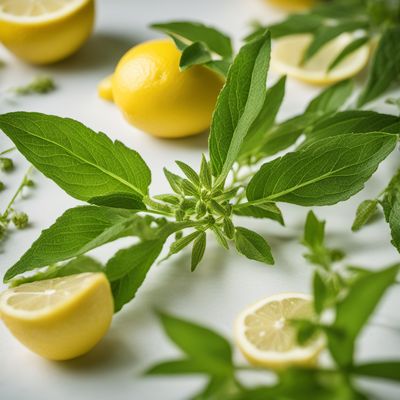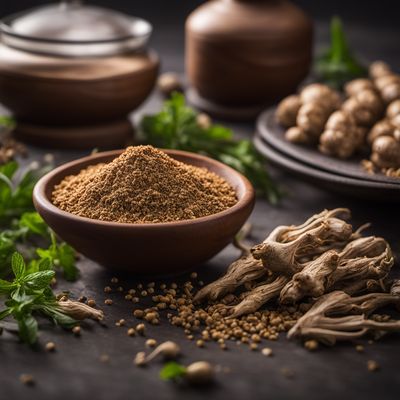
Ingredient
Jasmine infusion
"Aromatic Elixir: Unveiling the Delicate Essence of Jasmine Infusion"
Jasmine infusion is a translucent liquid with a pale yellow hue, exuding a captivating floral aroma that is both delicate and intoxicating. It possesses a smooth and soothing texture, making it a delightful addition to various dishes and beverages. The infusion imparts a subtly sweet and floral taste, with hints of honey and a refreshing aftertaste.
Origins and history
Jasmine flowers have a long history in Asian cultures, particularly in China and India, where they are revered for their beauty and fragrance. The practice of infusing jasmine flowers in hot water dates back centuries and is deeply rooted in Chinese tea culture. It later spread to other parts of Asia and gained popularity worldwide.
Nutritional information
Jasmine infusion is low in calories and does not contain any significant nutrients. It is primarily enjoyed for its aromatic and sensory qualities rather than its nutritional value.
Allergens
Jasmine infusion is generally considered safe for consumption and is not known to be a common allergen. However, individuals with specific allergies to flowers or pollen should exercise caution.
How to select
When selecting jasmine infusion, look for high-quality products that use real jasmine flowers rather than artificial flavorings. Opt for reputable brands or loose-leaf teas that clearly state the use of natural jasmine flowers in the ingredients list. The aroma should be strong and fragrant, and the packaging should be airtight to preserve freshness.
Storage recommendations
To maintain the freshness and quality of jasmine infusion, store it in an airtight container away from direct sunlight and strong odors. It is best consumed within a few months to fully appreciate its aromatic qualities.
How to produce
Producing jasmine infusion at home requires fresh jasmine flowers and hot water. Simply place a handful of jasmine flowers in a teapot or heat-resistant container, pour hot water over them, and let it steep for a few minutes. Strain the liquid and discard the flowers, and your homemade jasmine infusion is ready to be enjoyed.
Preparation tips
Jasmine infusion can be used in various ways, such as adding it to teas, cocktails, desserts, or even savory dishes. For a soothing cup of jasmine tea, steep a teaspoon of jasmine infusion in hot water for 3-5 minutes. Experiment with incorporating jasmine infusion into ice creams, custards, or syrups to infuse a floral note into your culinary creations.
Culinary uses
Jasmine infusion is commonly used in Asian cuisines, particularly in Chinese, Thai, and Vietnamese dishes. It is often added to rice, stir-fries, marinades, and sauces to impart a delicate floral aroma and flavor. Additionally, it can be used to enhance the taste of desserts, such as cakes, puddings, and sorbets.
Availability
Jasmine infusion is commonly available in Asian grocery stores, specialty tea shops, and online retailers. It is cultivated in countries like China, India, Thailand, and Vietnam.
More ingredients from this category » Browse all

Fruit infusion
Refreshing Fruit Infusion

Camomile infusion
"Soothing Serenity: Unveiling the Delicate Elixir of Camomile"

Lemon verbena infusion
The Zesty Elixir: Unveiling the Delights of Lemon Verbena Infusion

Elderflowers infusion
The Fragrant Elixir: Elderflower Infusion

Gingko infusion
The Golden Elixir: Unveiling the Secrets of Gingko Infusion

Peppermint infusion
Refreshing Peppermint: A Cooling Herbal Elixir

Rose infusion
"The Fragrant Elixir: Exploring the Delicate Flavors of Rose Infusion"

Lime blossoms infusion
The Fragrant Elixir of Lime Blossoms

Valerian root infusion
The Tranquil Elixir: Valerian Root Infusion

Hibiscus infusion
The Vibrant Elixir

Rooibos infusion
The Red Bush Elixir

Maté infusion
The Energizing Elixir
Recipes using Jasmine infusion

Chinese-style Tiramisù
Silk Road Tiramisù: A Fusion of Italian and Chinese Flavors

Jiangxi Bluf
Silken Clouds of Jiangxi: A Delicate Dessert Delight

Jiangsu-style Budyń Pudding
Silky Sweet Delight: Jiangsu-style Budyń Pudding

Shanghai-style Bird's Milk
Silky Delight: Shanghai-style Bird's Milk

Thong Yip - Thai Sweet Egg Yolk Dessert
Golden Delights: A Sweet Thai Egg Yolk Sensation

Bahraini Spiced Tea-Smoked Chicken
Saffron-infused Tea-Smoked Chicken with Bahraini Spice Blend

Putian-style Cream Cake
Silky Delight: Putian-style Cream Cake

Matzvnis with a Twist: A Fusion of Georgian and Australasian Flavors
Pacific-inspired Matzvnis: A Fusion of Georgian and Australasian Delights

Refreshing Thai Rice Soaked in Jasmine Water
Jasmine Delight: A Cool and Fragrant Thai Rice Dish